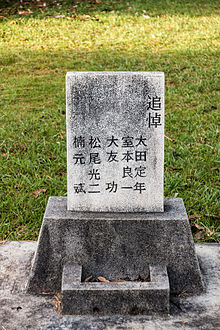Tugu Peringatan Perang Jepun Tawau
Tugu Peringatan Perang Jepun Tawau or Japanese Cemetery Tawau is a former cemetery in Tawau in the Malaysian state of Sabah . Today it has been rededicated as a memorial.
history
As a direct result of the Anglo-Japanese Treaty of 1902 , Japanese businessmen began to settle in Tuawau and the surrounding area. On January 19, 1916, the Japanese Nihon Sangyo Kabushiki Kaisha (Nippon Industrial Company) bought 240 hectares of rubber plantation and 607 hectares of adjacent land. The plantation became known as Kuhara Rubber and Manila Hemp Estates under the name of its owner, Fanosuke Kuhara . Another Japanese plantation that belonged to the Japanese Umeme Kubota was the Kubota Coconut Estates, which specialized in coconuts, from 1916 onwards . The 1921 population statistics show 191 Japanese in Tawau; when the Second World War broke out there were already 1,175.
For the growing number of Japanese, the cemetery was built before the Second World War and was used as a burial place by the Japanese community in Tawau. The vast majority of those buried here died in the years before the Second World War.
description
The former cemetery grounds are on Jalan Tanjung Batu Road , west of the golf course. The area is fenced in on three sides. Only a few relics remain of its original function as a cemetery.
The path from the entrance gate leads to a large stone slab about 2 m high and rounded on the upper side, which stands on a base about 50 cm high. The characters on the front mean "Japanese collective grave". The stele is flanked on both sides by a rectangular flower trough. On the far left side there was formerly a memorial stone and on the far right side there was a square stone column with an onion-shaped end.
Of the individual graves, only one tombstone with the inscription "Mourning" and the listing of five Japanese names - Sadatoshi Ohta, Ryoichi Muromoto, Isao Ohtomo, Koji Matsuo and Takeshi Kusumoto - has survived.
Two marker stones in the style of a tombstone indicate the location of the former crematorium and a water basin belonging to the cemetery. The outlines of the former crematorium are clearly visible on the green area; at the four corners are the remains of plinth foundations with attached steel tubes.
On the back of the destroyed memorial stone there are several rows of characters on a metal sign, the translation of which is as follows:
|
SORRY FOR THE DEAD |
literature
- Ken Goodlet: Tawau - The Making of a Tropical Community , Opus Publications, 2010 ISBN 978-983-3987-38-2
Web links
Individual evidence
- ↑ Goodlet, pp. 39/41
- ↑ The Japanese cemetery in Tawau ; Accessed August 19, 2012
Remarks
- ↑ As an alternative translation "Japanese community grave" is possible.
- ↑ At the time of the on-site exploration in July 2012, the front of the memorial stone was destroyed. The stone pillar lay on the floor, broken in four.
- ↑ The translation of names from Japanese into German is only possible roughly, as Japanese names can be read in different ways. The writing can be read from right to left and from top to bottom.
- ↑ The 63 year of the Shōwa period - the reign of Tennō Hirohito - corresponds to the year 1988. The date is 25 May 1988.
Coordinates: 4 ° 16 '0.8 " N , 117 ° 52' 40.7" E



